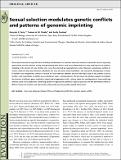Files in this item
Sexual selection modulates genetic conflicts and patterns of genomic imprinting
Item metadata
| dc.contributor.author | Faria, Gonçalo S. | |
| dc.contributor.author | Varela, Susana A. M. | |
| dc.contributor.author | Gardner, Andy | |
| dc.date.accessioned | 2017-01-16T14:30:18Z | |
| dc.date.available | 2017-01-16T14:30:18Z | |
| dc.date.issued | 2017-03-07 | |
| dc.identifier | 248127006 | |
| dc.identifier | 9142fd3f-c24f-41ed-b534-b522235c762b | |
| dc.identifier | 85010567536 | |
| dc.identifier | 000396039000002 | |
| dc.identifier.citation | Faria , G S , Varela , S A M & Gardner , A 2017 , ' Sexual selection modulates genetic conflicts and patterns of genomic imprinting ' , Evolution , vol. 71 , no. 3 , pp. 526-540 . https://doi.org/10.1111/evo.13153 | en |
| dc.identifier.issn | 0014-3820 | |
| dc.identifier.other | ORCID: /0000-0002-1511-8680/work/30765800 | |
| dc.identifier.uri | https://hdl.handle.net/10023/10111 | |
| dc.description | This work was supported by Portuguese National Funds, through FCT - Fundação para a Ciência e a Tecnologia, within the project UID/BIA/00329/2013, as well as through GFS PhD Scholarship (SFRH/BD/109726/2015) and through SAMV Post-Doctoral Research Grant (SFRH/BPD/66042/2009), and by a Natural Environment Research Council Independent Research Fellowship (AG, Grant Number NE/K009524/1). | en |
| dc.description.abstract | Recent years have seen a surge of interest in linking the theories of kin selection and sexual selection. In particular, there is a growing appreciation that kin selection, arising through demographic factors such as sex-biased dispersal, may modulate sexual conflicts,including in the context of male-female arms races characterized by coevolutionary cycles.However, evolutionary conflicts of interest need not only occur between individuals, but may also occur within individuals, and sex-specific demography is known to foment such intragenomic conflict in relation to social behavior. Whether and how this logic holds in the context of sexual conflict – and, in particular, in relation to coevolutionary cycles – remains obscure. We develop a kin-selection model to investigate the interests of different genes involved in sexual and intragenomic conflict, and we show that consideration of these conflicting interests yields novel predictions concerning parent-of-origin-specific patterns of gene expression and the detrimental effects of different classes of mutation and epimutation at loci underpinning sexually-selected phenotypes. | |
| dc.format.extent | 15 | |
| dc.format.extent | 1170618 | |
| dc.language.iso | eng | |
| dc.relation.ispartof | Evolution | en |
| dc.subject | Arms race | en |
| dc.subject | Dispersal | en |
| dc.subject | Inclusive fitness | en |
| dc.subject | Intragenomic conflict | en |
| dc.subject | Kin selection | en |
| dc.subject | Sexual conflict | en |
| dc.subject | GE Environmental Sciences | en |
| dc.subject | QH301 Biology | en |
| dc.subject | QH426 Genetics | en |
| dc.subject | DAS | en |
| dc.subject.lcc | GE | en |
| dc.subject.lcc | QH301 | en |
| dc.subject.lcc | QH426 | en |
| dc.title | Sexual selection modulates genetic conflicts and patterns of genomic imprinting | en |
| dc.type | Journal article | en |
| dc.contributor.sponsor | NERC | en |
| dc.contributor.institution | University of St Andrews. School of Biology | en |
| dc.contributor.institution | University of St Andrews. Centre for Biological Diversity | en |
| dc.identifier.doi | https://doi.org/10.1111/evo.13153 | |
| dc.description.status | Peer reviewed | en |
| dc.identifier.grantnumber | NE/K009524/1 | en |
This item appears in the following Collection(s)
Items in the St Andrews Research Repository are protected by copyright, with all rights reserved, unless otherwise indicated.

